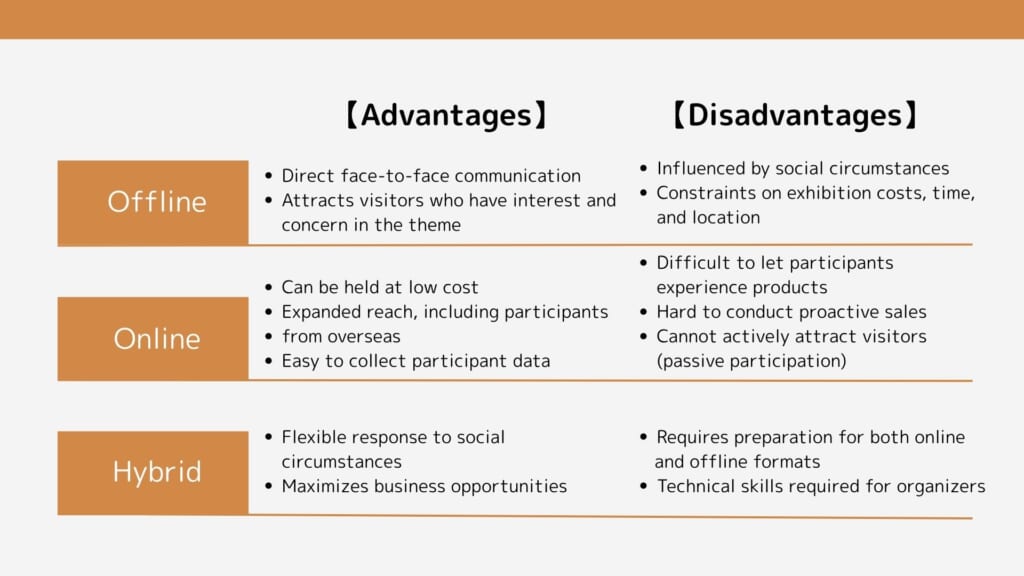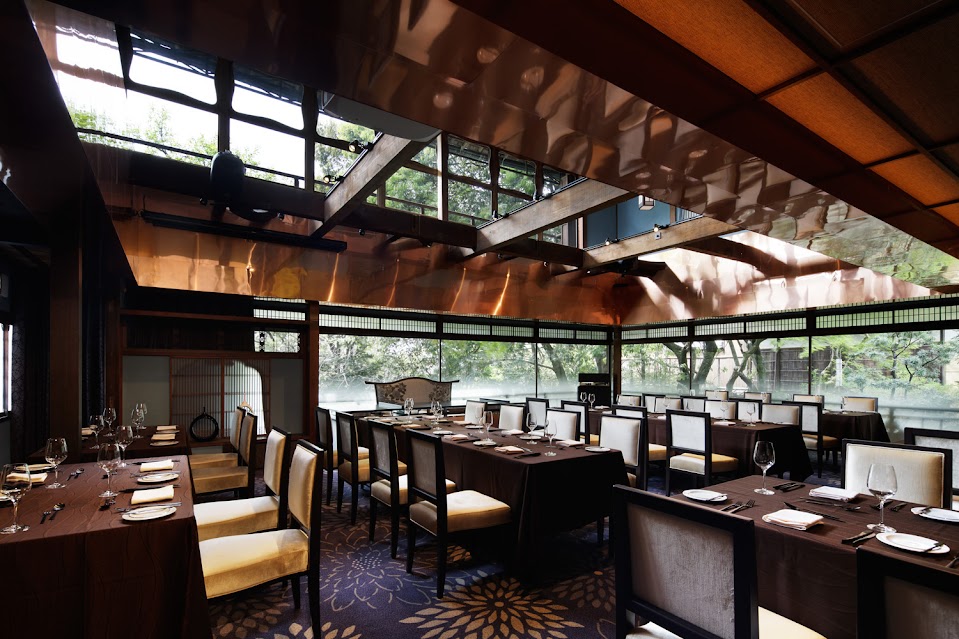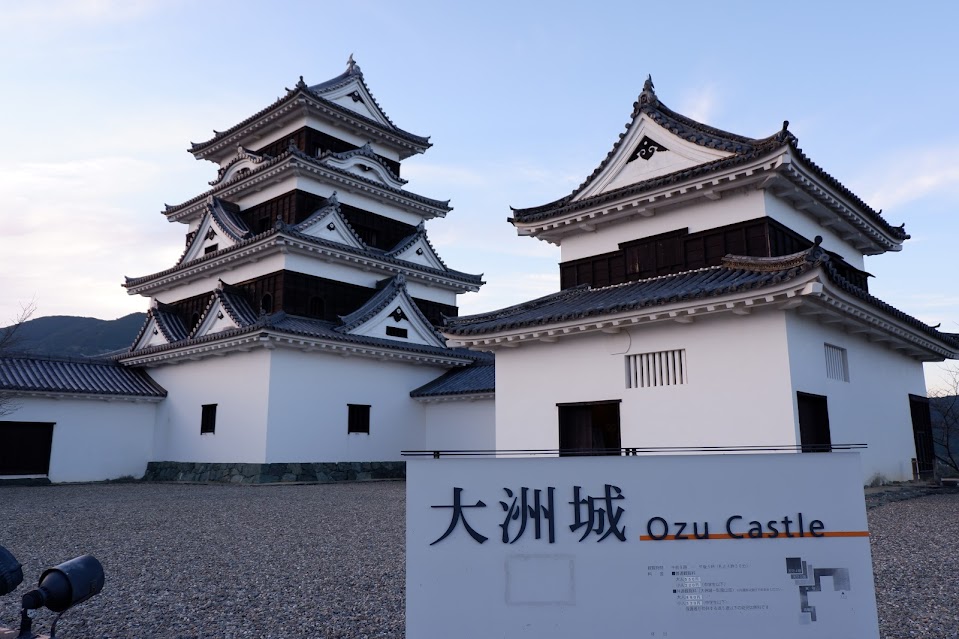A New Style of Post-COVID Exhibitions Showcased in Distinctly “Japanese” Venues“
2025.7.3
column
Table of Contents
- The New Form of Exhibitions in the Recovery Phase
- The Impact of COVID-19 on Exhibitions and Events During the Pandemic
- Three Options for Exhibitions in the New Era
- Unique Venues” as a New Choice for Exhibition Spaces
- The Strengths of UNIQUE VENUES OF JAPAN
The New Form of Exhibitions Required in the Current Recovery Phase

The COVID-19 pandemic, which began in 2020, drastically changed our way of life and significantly reduced opportunities for face-to-face interactions. Traditionally, exhibitions have been held primarily in-person, serving as a platform for launching new products, showcasing existing offerings, and acquiring new customers. However, the spread of COVID-19 dealt a severe blow to such in-person events. As the prolonged pandemic reshaped society, the exhibition industry also evolved, giving rise to new formats beyond traditional offline events — including fully online exhibitions and hybrid models that combine both in-person and virtual elements.
Since around 2021, in-person events have gradually resumed, and we are now entering what can be called the “exhibition recovery phase.” With multiple formats now available — offline, online, and hybrid — this moment presents an ideal opportunity to move beyond conventional approaches and create new forms of exhibitions that are aligned with the times and targeted audiences. We propose a fresh vision for exhibitions utilizing Japan’s distinctive “unique venues” — one-of-a-kind spaces that offer a uniquely Japanese atmosphere.
The Impact of COVID-19 on Trade Shows and Exhibitions
-The Effects During the Pandemic

In a media release dated March 10, 2020, the Global Association of the Exhibition Industry (UFI) announced that the cancellations and postponements of exhibitions due to the COVID-19 pandemic had resulted in the loss of at least USD 26.3 billion (approximately JPY 2.7 trillion) in business opportunities. As of that date, the exhibition and events industry had already incurred losses amounting to USD 16.5 billion (approximately JPY 1.7 trillion). Of the USD 26.3 billion loss in business opportunities, approximately USD 14.6 billion, or 55.5% of the total, was attributed to the Asia-Pacific region.
According to a survey conducted by the Japan Association for the Promotion of the Event Industry (JAPE), the market size of the “dedicated event segment,” which includes exhibitions, trade fairs, sports events, and other events organized by specialized event companies, stood at JPY 203.1 billion in 2019, prior to the pandemic. However, this figure plummeted to JPY 95.5 billion in 2020.
These figures illustrate that the exhibition market, which had been predominantly reliant on in-person events, suffered a severe setback due to the pandemic. The significant blow to exhibitions, which served as a key platform for acquiring new clients, subsequently impacted broader business activities.
By 2021, however, as the pandemic persisted, new lifestyles and social frameworks began to emerge. The same JAPE survey reports that the market size of the dedicated event segment gradually recovered to JPY 162.5 billion in 2021 and JPY 188.9 billion in 2022, reaching 93.0% of the pre-pandemic level by 2022.
【References, URL】
Japan Association for the Promotion of the Event Industry, 2022 Event Industry Market Size Estimates
-New Forms of Trade Shows Emerging Amid the COVID-19 Pandemic
Traditionally, the trade show market had been dominated by in-person (offline) events. However, during the COVID-19 pandemic, opportunities for face-to-face interaction drastically declined, and the rapid adoption of telework and online meetings accelerated the shift toward remote and online practices across society. The trade show market was no exception to this trend, and alongside traditional offline formats, new forms of trade shows emerged: online and hybrid formats.
The online format, often referred to as “web-based trade shows,” involves exhibitions held entirely online without any physical venue. In contrast, the hybrid format incorporates both offline and online elements. This approach combines traditional in-person exhibitions at physical venues with live streaming and digital content, enabling remote business negotiations and interactions alongside on-site activities.
 【References, URL】
【References, URL】
EXPOLINE, Hybrid Trade Shows Combining Online and In-Person Elements: Overview and Appeal
Three Options for Trade Shows in the New Era

As we have seen, the nature of trade shows has undergone significant changes during the COVID-19 pandemic, giving rise to three options: offline, online, and hybrid formats. In the following, we will examine the advantages and disadvantages of each of these three options for trade shows in the new era.
■Advantages of the Offline Format
・Enables direct communication between companies and participants.
・Potential to generate new leads as participants may visit other booths on their way to their original target booths.
・Attendees generally have a strong interest in the theme, resulting in highly qualified leads.
■Disadvantages of the Offline Format
・Vulnerable to changes in social conditions, such as the spread of COVID-19.
・Incurs significant exhibition costs.
・Subject to time and location constraints.
■Advantages of the Online Format
・Can be held at lower cost without location constraints.
・Broader reach as participants can join from overseas.
・Easier to collect participant data.
■Disadvantages of the Online Format
・Participants cannot physically handle or experience the products.
・Difficult to approach participants directly, making proactive sales challenging.
・Relies on participants to voluntarily join, as active outreach (e.g., booth invitations) is not possible.
■Advantages of the Hybrid Format
・Allows both organizers and participants to flexibly adapt to changing social conditions.
・Enables engaging events with live streaming while avoiding overcrowding.
・Maximizes business opportunities by combining both offline and online elements.
■Disadvantages of the Hybrid Format
・Requires preparation for both offline and online components.
・Demands technical skills on the part of the organizers.

【References, URL】
TECH+, What is an Offline Exhibition? From Advantages and Disadvantages to Tips for Success
CrowdBooth, What is an Online (Virtual) Exhibition? Introducing Its Advantages and Disadvantages
EXPOLINE,Hybrid Trade Shows Combining Online and in-Person Elements: Overview and Appeal
iPresence, Overview of Hybrid Events (Advantages and Disadvantages) and Future Prospects
The Option of “Unique Venues” for Exhibition Sites
-What is a Unique Venue?

Now that new options have emerged in the trade show market, it is essential to select the most appropriate format—offline, online, or hybrid—according to the times and target audiences, and to organize trade shows suited for this new era. With the advent of online and hybrid formats, trade shows are no longer bound by physical location, making international participation one of the key factors for the success of exhibitions in the new era.
Have you heard of Unique Venues, a venue option that offers a distinctly Japanese, one-of-a-kind space, different from conventional exhibition centers or convention halls?
Unique Venues refer to special locations that provide visitors with experiences unique to the local area and offer something that cannot be replicated elsewhere. These include historic buildings, shrines and temples, castles, museums, and art galleries, where conferences and receptions can be held. By utilizing such venues, organizers can create a sense of exclusivity and highlight regional characteristics.
【References, URL】
Japan Tourism Agency, Unique Venues
-The Value of Holding Trade Shows at Unique Venues

The greatest feature of Unique Venues lies in their one-of-a-kind “Japaneseness.” Each unique venue offers an unparalleled and distinctive atmosphere. Holding a trade show in such a setting leaves a strong impression on attendees and makes the event more memorable. Unique Venues embody the history cultivated by the buildings themselves and the people connected to them, offering a sense of warmth and authenticity that conventional exhibition centers or convention halls lack. This distinctive character helps convey a sense of passion and warmth to participants—elements that have become increasingly difficult to communicate in a world that rapidly shifted to remote and online interactions during the COVID-19 pandemic.
Furthermore, the distinctly Japanese atmosphere of Unique Venues allows trade show participants to enjoy extraordinary experiences. Offline attendees can physically immerse themselves in the unique space, feeling the essence of Japan as they engage with companies’ presentations. Online attendees can sense the unique warmth and passion conveyed by these venues, enhancing the impact of the companies’ promotional messages. For international participants, Unique Venues offer a special opportunity to experience Japanese culture alongside the business presentations, potentially inspiring future visits to Japan.
The value of selecting Unique Venues as sites for trade shows in the new era lies in their unmatched warmth and “Japaneseness,” which cannot be found in conventional venues. By offering participants a special experience through a new approach to trade show organization, Unique Venues enhance attendees’ interest and engagement with participating companies.
【References, URL】
Job Soken, In-House Communication Survey Report
Strengths of UNIQUE VENUES OF JAPAN

At UNIQUE VENUES OF JAPAN, we centralize information on carefully selected unique venues from across Japan and provide one-stop support for planning, coordinating, preparing, and managing MICE and other events held in these extraordinary locations. As the exhibition market undergoes significant transformation in the post-COVID era, we are committed to walking alongside our clients from the very early planning stages, addressing concerns and uncertainties together as we navigate this new exhibition landscape.
Now, with the emergence of three exhibition formats—offline, online, and hybrid—there is a growing need for trade shows tailored to the times and target audiences. Why not take advantage of uniquely Japanese venues to offer all participants—whether attending in person, online, through hybrid formats, or joining from overseas—a truly special experience? By adopting this unique approach, you can create exhibitions that capture greater interest and engagement in your company.
There is a level of uniqueness that can only be found in these special venues. If you are interested, please feel free to contact us via the link below. We look forward to supporting you.
Contact Us Here
PLACE
Find a venue
Spend time with your loved ones,
at a one-of-a-kind location
where you can experience Japanese culture.







